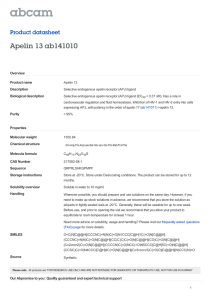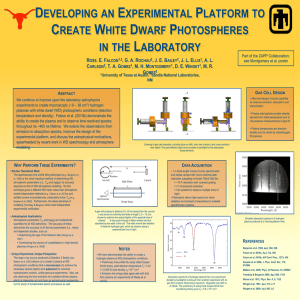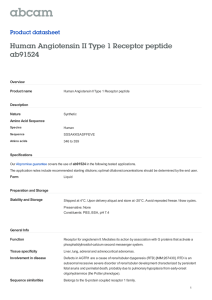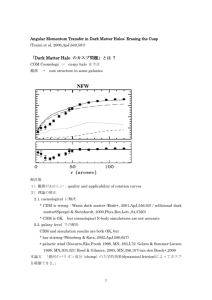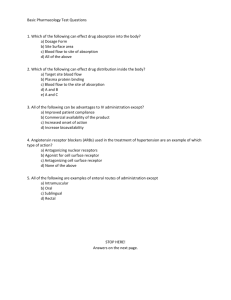APJ system − Translational promise of the apelin
advertisement
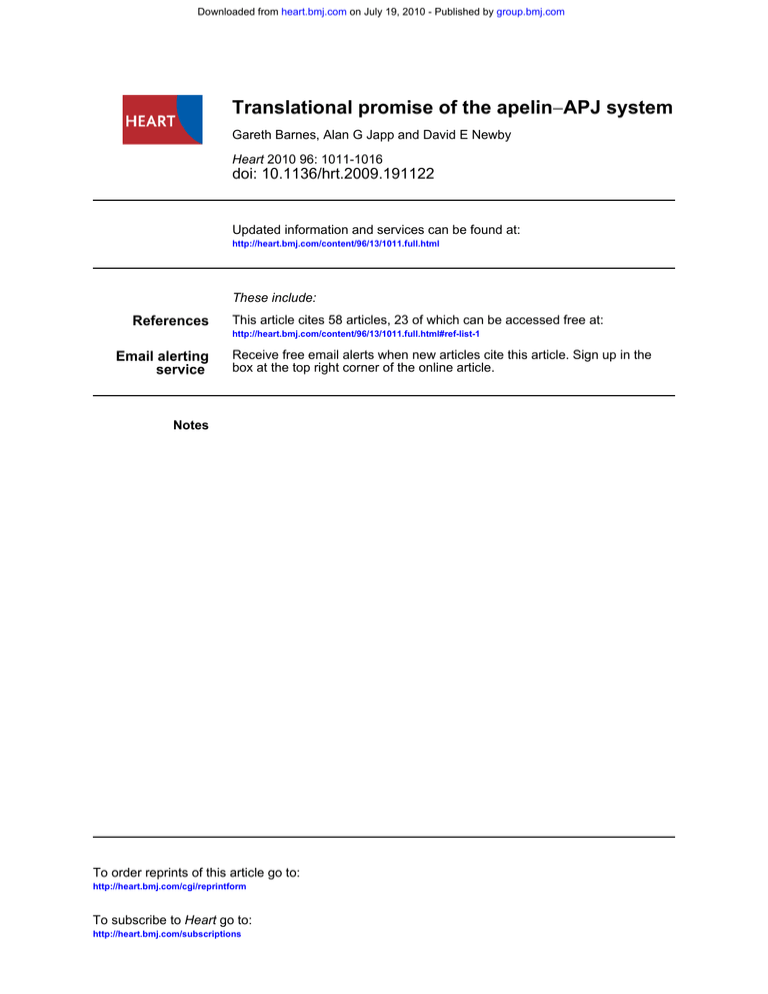
Downloaded from heart.bmj.com on July 19, 2010 - Published by group.bmj.com Translational promise of the apelin−APJ system Gareth Barnes, Alan G Japp and David E Newby Heart 2010 96: 1011-1016 doi: 10.1136/hrt.2009.191122 Updated information and services can be found at: http://heart.bmj.com/content/96/13/1011.full.html These include: References This article cites 58 articles, 23 of which can be accessed free at: http://heart.bmj.com/content/96/13/1011.full.html#ref-list-1 Email alerting service Receive free email alerts when new articles cite this article. Sign up in the box at the top right corner of the online article. Notes To order reprints of this article go to: http://heart.bmj.com/cgi/reprintform To subscribe to Heart go to: http://heart.bmj.com/subscriptions Downloaded from heart.bmj.com on July 19, 2010 - Published by group.bmj.com Translational medicine Translational promise of the apelineAPJ system Gareth Barnes,1 Alan G Japp,2 David E Newby1,2 1 Centre for Cardiovascular Science, University of Edinburgh, Edinburgh, UK 2 Edinburgh Heart Centre, Royal Infirmary of Edinburgh, Edinburgh, UK Correspondence to Dr Gareth Barnes, Rm SU305 The Chancellors Building, 49 Little France Crescent, University of Edinburgh, Edinburgh EH16 4SA, UK; gareth.barnes@ed.ac.uk Accepted 19 March 2010 ABSTRACT Apelin, the endogenous ligand for the G-protein-coupled APJ receptor, is emerging as a key hormone in cardiovascular homoeostasis. It is expressed in a diverse range of tissues with particular preponderance for the cardiovascular system, being found in both the heart and vasculature. Apelin is the most potent in vitro inotrope yet identified and causes endothelium- and nitric oxidedependent vasodilatation. It also appears to have a role in lipid and glucose metabolism as well as fluid homoeostasis. One of the key emerging features of the apelineAPJ system is its interaction with the renineangiotensin system with the respective receptors sharing marked sequence homology, forming heterodimers, and mediating opposing physiological actions. To date, both preclinical and limited clinical studies suggest that the apelineAPJ system may have an important role in the pathogenesis of heart failure. Although the apelineAPJ system is downregulated, the inotropic actions of apelin persist and are enhanced in failing hearts without inducing ventricular hypertrophy. In combination with its interaction with the renineangiotensin system, APJ agonism may provide a new therapeutic target in the treatment of acute and chronic heart failure. In this review, we highlight key aspects of the apelineAPJ system in health and disease, and consider its translational and therapeutic potential. The diverse actions of the apelineAPJ system have implications for understanding the pathophysiology of, and development of treatments for, several major cardiovascular diseases. The APJ receptor and its ligand, apelin, constitute a relatively new peptidic system with an emerging and important physiological and pathophysiological role that is currently being defined (figure 1). In vitro and preclinical models have suggested that the apelineAPJ system has a role in cardiovascular homoeostasis as well as fluid balance and metabolism. We will here review the apelineAPJ system and explore its emerging pathogenetic significance and therapeutic potential in cardiovascular disease. APELIN AND THE APJ RECEPTOR The APJ receptor is a G-protein-coupled receptor first identified in 1993.1 It is expressed in a wide range of tissues, including the endothelium, myocardium,2 3 vascular smooth muscle,4 adipose tissue3 and throughout the brain.5 6 It remained ‘orphaned’ until 1998 when apelin (APj receptor Endogenous LIgaNd) was extracted from bovine stomach.7 It is unclear whether apelin acts on the APJ receptor in an autocrine, paracrine or hormonal manner but most evidence supports a paracrine focus of action. Heart 2010;96:1011e1016. doi:10.1136/hrt.2009.191122 Apelin is synthesised as a 77 amino acid prepropeptide that is cleaved into a mature 36 amino acid peptide. Shorter more active isoforms have also been identified, with the pyroglutamated 13 amino acid apelin, (Pyr1)apelin-13, being the most potent,3 and abundant form in cardiac tissue.8 The main source of plasma apelin is currently unclear, although the vascular endothelium and the atria of the heart are likely to be significant contributors.9 The pathway of apelin metabolism and breakdown is currently obscure but the mature 77 amino acid peptide contains a number of basic residues that are potential cleavage sites for peptidases. Apelin has a brief plasma half-life of <5 min in man and its cardiovascular effects are relatively short lived.10 11 PHYSIOLOGICAL ACTIONS OF THE APELINeAPJ SYSTEM Vascular actions Apelin causes vasodilatation in ex vivo models employing human conduit arteries,8 resistance vessels12 and veins.8 Accordingly, intravenous administration in rodents reduces mean arterial pressure,13e16 systemic venous tone15 and cardiac preload and afterload.17 Vasodilatation to apelin is endothelium dependent since vasoconstriction occurs in endothelium-denuded vessels.8 18 This endothelium-dependent vasodilatation appears to be mediated predominantly through nitric oxidedependent pathways: in vitro, apelin stimulates transcription19 and phosphorylation13 of endothelial nitric oxide synthase and, in vivo, it increases plasma nitrate and nitrite concentrations.14 Furthermore, inhibition of nitric oxide synthase markedly attenuates both the depressor14 and vasodilator12 responses to apelin. In human mammary arteries and saphenous veins, although not mesenteric resistance vessels, apelin induces vasodilatation through a prostacyclin-dependent pathway.8 The vascular effects of apelin in clinical studies mirror those in animal models. Intra-arterial infusion of apelin causes reproducible vasodilatation in the human forearm arterial circulation.11 In this model, vasodilatation to apelin is reduced by twothirds during nitric oxide synthase inhibition but is unaffected by prostacyclin inhibition.11 Apelin does not appear to exert in vivo vasomotor effects in human dorsal hand veins, but the effects on central capacitance vessels have yet to be studied. Currently available clinical data are limited to studies on these two regional vascular beds. However, recent data from our own group demonstrates that apelin is also a coronary vasodilator and, when administered at systemic doses, reduces peripheral vascular resistance.10 1011 Downloaded from heart.bmj.com on July 19, 2010 - Published by group.bmj.com Translational medicine Figure 1 Physiological and pathophysiological roles of apelin. Cardiac actions Apelin is among the most potent endogenous inotropic agents yet described. In vitro, exogenous apelin increases contractility at subnanomolar concentrations in atrial strips8 and whole rat hearts,20 and increases sacromere shortening by up to 140% in single cardiomyocytes.2 In healthy rodents, acute apelin infusion increases myocardial contractility17 independently of its effects on loading conditions while, uniquely among current inotropic agents, chronic dosing causes a sustained increase in cardiac output without inducing left ventricular hypertrophy.17 Recent studies have confirmed that endogenous apelineAPJ signalling contributes to cardiac function. Isolated ventricular myocytes from both apelin- and APJ-deficient mice have impaired sarcomeric function resulting in reduced myocyte contractility.21 While apelin-deficient mice display normal or only slightly impaired basal cardiac function, they have marked reductions in exercise capacity and maximum oxygen consumption. They manifest progressive cardiac dysfunction from 6 months of age and develop severe heart failure when subjected to chronic pressure overload via surgical aortic banding.22 Taken together, these data suggest a critical role for apelineAPJ signalling in maintaining and augmenting cardiac performance during conditions of cardiovascular stress. The inotropic actions of apelin are independent of angiotensin II, endothelin-1, catecholamines and nitric oxide release.20 Although the data are to some extent conflicting, it appears that apelin acts predominantly through mechanisms other than by raising intracellular calcium concentrations. In intact rat hearts, the inotropic response to apelin is markedly attenuated by selective inhibition of the sacrolemmal sodium-hydrogen ion exchanger (NHE). Stimulation of NHE can lead to intracellular alkalinisation and sensitisation of cardiac myofilaments to intracellular calcium ions.23 Accordingly, in isolated cardiomyocytes, apelin activates NHE and reduces intracellular pH.2 In these and other studies20 of isolated cardiomyocytes, apelin had no effect on calcium ion transients. Furthermore, isolated cardiomyocytes from APJ- and apelin-deficient mice with impaired contractile function, also show no alterations in calcium ion transients.21 However, apelin causes a modest increase in the amplitude of the intracellular calcium ion transients in failing rat trabeculae24 and isolated cardiomyocytes,25 1012 suggesting the possibility of an additional mechanism involving increased calcium availability. Fluid homoeostasis Apelin and the APJ receptor are present in the kidney and many areas of the brain. High concentrations are found in the supraoptic nuclei and paraventricular nuclei6: regions involved in fluid homoeostasis. Here, the synthesis and secretion of apelin appears to be regulated by vasopressin.26 In turn, intracerebral injection of apelin directly inhibits vasopressin release leading to a 40% reduction in plasma vasopressin concentrations. In keeping with this, apelin has diuretic properties27 28 that appear to be primarily aquaretic with little or no apparent increase in sodium excretion.27 In man, water loading results in elevated plasma apelin concentrations, while increased plasma osmolality causes plasma apelin concentrations to fall; in each case there is a reciprocal change in vasopressin concentration.29 Overall, these data suggest that apelin may have an important counter-regulatory role to vasopressin in fluid homoeostasis. Glucose metabolism Apelin is produced in vitro by adipose tissue30 and influences glucose and lipid metabolism as an adipocytokine. Exogenous apelin reduces the peak plasma glucose concentration after a glucose load by increasing glucose turnover,31 through insulindependent and -independent pathways. Apelin-deficient animal models have reduced insulin sensitivity and this can be corrected by the administration of exogenous apelin.32 The effect of exogenous apelin on glucose handling in man is currently unknown. However, increases in plasma apelin concentrations are seen during oral glucose tolerance tests in healthy individuals.33 THE APELIN-APJ AND RENINeANGIOTENSIN SYSTEMS Among the G-protein coupled receptors, APJ displays the closest sequence homology to the angiotensin II type 1 (AT1) receptor at around 50%, predominantly within the transmembrane domains. Furthermore, similar patterns of tissue expression are evident for both receptors.34 However, apelin mediates opposing actions to angiotensin II on vascular tone, blood pressure and fluid homoeostasis, suggesting a counter-regulatory role for Heart 2010;96:1011e1016. doi:10.1136/hrt.2009.191122 Downloaded from heart.bmj.com on July 19, 2010 - Published by group.bmj.com Translational medicine apelin in relation to the renineangiotensin system. Indeed, increasing evidence points to direct interactions between the two systems at both molecular and transcriptional levels (figure 2). Apelin attenuates the vasoconstrictor effects of angiotensin II through both nitric oxide-dependent and -independent pathways.35 36 In contrast, APJ-deficient mice exhibit an exaggerated pressor response to exogenous angiotensin II.13 More recently, Chun et al37 demonstrated physiological antagonism of angiotensin II signalling pathways by apelin including extracellular signal-regulated kinase phosphorylation and activation of transcriptional targets, such as nuclear factor-kB. Importantly, apelin had no effect on the constitutive transcription of these targets and functioned only to inhibit the actions of angiotensin II. There appears to be a direct counter-regulation of the apelineAPJ system by angiotensin II that extends to APJ receptor and apelin gene expression. In rats, infusion of angiotensin II for 24 h, even at sub-pressor doses, reduces cardiac apelin expression: an effect abolished by concurrent AT1 receptor blockade.38 In contrast, in hypertensive animal models that have elevated AT1 receptor and reduced APJ receptor and apelin concentrations, inhibition of AT1 receptor transcription results in dose-dependent increases in APJ receptor and apelin concentrations.39 This is accompanied by a reduction in blood pressure that appears to be mediated by nitric oxide. The AT1 and APJ receptors can form heterodimers (figure 2).37 This heterodimerisation has, as yet, only been observed in vitro at high receptor densities and this may not accurately reflect the in vivo situation in native tissues. Functionally the formation of heterodimers influences downstream signalling and is independent of apelin but promoted by angiotensin II. Thus, in addition to suppressing apelin and APJ expression, it may be plausible that by triggering formation of heterodimers, angiotensin II serves to limit the number of APJ receptors available for activation by apelin. In summary, there may be reciprocal counter-regulation between the apelineAPJ and renineangiotensin systems. Given that the apelineAPJ pathway appears to be inhibited by angiotensin II, this raises the possibility of therapeutic synergism by combining APJ receptor agonism with inhibition of the renineangiotensin system. APELIN-APJ SYSTEM: TRANSLATIONAL POTENTIAL IN CLINICAL DISEASE Heart failure Data from apelin-deficient mice indicate that endogenous apelin activity may help to maintain cardiac performance under conditions of cardiovascular stress. However, the apelineAPJ system appears to undergo downregulation in heart failure. In an in vivo rodent model of hypertensive heart disease, expression of cardiac apelin and APJ receptor is increased or maintained at the stage of left ventricular hypertrophy but declines dramatically with the transition to overt heart failure.38 Similar reductions in cardiac APJ expression are seen in other in vitro20 and in vivo animal models of heart failure. In humans, cardiac APJ expression is reduced in patients with chronic heart failure secondary to dilated cardiomyopathy.9 Interestingly it is preserved in those with an ischaemic aetiology,9 perhaps reflecting the stimulatory effect of local hypoxia on APJ expression.40e42 Several groups have also measured plasma apelin concentrations in patients with heart failure. In general, plasma apelin concentrations are maintained with mild to moderate left ventricular impairment but reduced with severe left ventricular impairment (see Japp and Newby43 for full discussion). The apparent decline in apelineAPJ activity in parallel with deteriorating cardiac performance suggests a potential role for diminished apelin signalling in the pathophysiology of heart failure. Strategies to augment apelin signalling may therefore help to retard the progression of heart failure. Significantly, in an isoproterenol-induced model of heart failure, left ventricular dysfunction is partially rescued by co-administration of apelin.44 Tentative evidence that alterations in endogenous apelineAPJ activity may modulate the progression of human heart failure was recently provided in a cohort of patients with dilated cardiomyopathy.45 In these patients, possession of a polymorphism of the APJ receptor, 212A (the biological significance of which is unknown), was associated with slower progression of heart failure. The unique haemodynamic profile of apelin in preclinical models suggests potential therapeutic utility in patients with established heart failure. Exogenous apelin potently enhances myocardial contractility without inducing left ventricular hypertrophy and achieves this while simultaneously reducing Figure 2 Proposed cellular interaction of the renineangiotensin and apelineAPJ systems. Heart 2010;96:1011e1016. doi:10.1136/hrt.2009.191122 1013 Downloaded from heart.bmj.com on July 19, 2010 - Published by group.bmj.com Translational medicine ventricular preload and afterload. Crucially, the beneficial effects of apelin on cardiac contractility and loading conditions are maintained in preclinical models of heart failure. In vitro, apelin increases contractility in the failing myocardium to the same2 or greater24 extent as in the normal myocardium. In vivo, acute apelin infusion restores ejection fraction, increases cardiac output and reduces left ventricular end-diastolic pressure in rats with chronic heart failure.42 46 Thus irrespective of alterations in receptor expression, these studies confirm that the APJ signalling capacity is not exhausted by endogenous apelin in established heart failure: an essential prerequisite for therapeutic strategies employing APJ agonism. Preliminary data from clinical studies are encouraging. We have recently demonstrated that the local vascular and systemic haemodynamic effects of acute apelin infusion, including a rise in cardiac output, are preserved in patients with stable chronic heart failure.10 Importantly, these patients continued to receive current optimal pharmacological treatment, suggesting that the effects of apelin were additive to established heart failure treatments. In particular, all but one of the patients were receiving treatment with ACE inhibitor or angiotensin receptor blocker treatment. Recent reports of direct interactions between the renineangiotensin and apelineAPJ systems have raised the possibility that some of the actions of apelin may be mediated through antagonism of angiotensin II.37 However, our findings imply a role for apelin that is independent of angiotensin II signalling pathways, and suggest a potential for pharmacological synergism through combined APJ agonism and renineangiotensin system inhibition. One further area of translational potential for apelin in heart failure is as a biomarker. As discussed above, plasma apelin concentrations appear to decrease in patients with advanced chronic heart failure and this process may coincide with a decline in cardiac performance. Although studies have reported conflicting findings, some apparent discrepancies are likely to be explained by marked differences in patient populations.43 Perhaps more importantly, there are significant concerns over the currently available commercial assays for apelin and how this has been used. Currently, there are no assays available to detect all isoforms, such as (Pry1)apelin-13. Equally there is an apparent lack of sensitivity and marked variation in measured concentrations with around 40-fold variation (90e3580 pg/ml)9 47 being reported among healthy control populations. However, this is likely to reflect insufficient extraction of plasma proteins in some studies, resulting in non-specific binding and reporting of falsely elevated plasma apelin concentrations. These issues are particularly important when assessing the potentially depressed plasma apelin concentrations reported in patients with heart failure. Interpretation is further complicated by an incomplete understanding of factors regulating the synthesis, post-translational processing and metabolism of apelin. The therapeutic potential of APJ agonism is an exciting area for translational research in heart failure. Further studies in animal models with predictable progression to heart failure should help to determine the ability of APJ agonism to prevent or delay decline in cardiac performance. Detailed clinical research is currently limited by the lack of longacting orally active therapeutic agents. While long-term APJ-apelin agonism may have therapeutic potential in patients with chronic heart failure, chronic dosing is not practicable or deliverable in the current context of parenteral administration of apelin peptide. The advent of oral APJ agonists will permit the further exploration of potential interactions between the renineangiotensin and apelineAPJ systems that will help to clarify the pathogenetic 1014 significance of altered apelin signalling in heart failure and the potential for therapeutic synergism with combined APJ agonism and renineangiotensin inhibition. In addition, the effects of sustained APJ agonism on cardiac contractility and systemic haemodynamics require characterisation and are an essential prerequisite for clinical trials in patients with acute decompensated or chronic heart failure. Finally, longitudinal studies of plasma apelin concentrations in patients with chronic heart failure will help to determine the utility of apelin as a novel biomarker. However, such studies are dependent on the development of an assay that identifies all of the major apelin isoforms. Vascular disease Apelin appears to have beneficial effects on vascular health. In diabetic mice, it increases vascular nitric oxide generation and reverses endothelial dysfunction.35 In ApoE-deficient mice, apelin infusion inhibits atherogenesis and completely abrogates angiotensin II-accelerated atherosclerosis, an effect that is independent of blood pressure.37 Indeed, double knockout mice, deficient in both apelin and ApoE, have accelerated atherosclerosis in comparison with isolated ApoE-deficient mice. These data imply an important anti-atherogenic role for endogenous apelin, and a potential therapeutic benefit from exogenous apelin in atherosclerosis.37 In contrast, one group has reported that combined knockout of the APJ receptor and ApoE in mice reduces atherosclerotic lesion formation,48 suggesting that APJ is required for progression of atherosclerosis. These contrasting findings are difficult to reconcile, although it is notable that these studies used very different fat feeding regimens. Future studies exploring the effects of pharmacological APJ antagonism in ApoE-deficient mice may help to clarify the situation and reveal if there are off-target genetic effects in one or other of the models. Recently, apelin treatment has reduced aneurysm formation by almost 50% in a mouse model of elastase-induced abdominal aortic aneurysms.49 Corresponding reductions in macrophage infiltration within the arterial wall and local expression of macrophage-colony stimulating factor (with strong trends towards reductions in tumour necrosis factor a, interleukin 6 and other proinflammatory cytokines) suggest that the predominant mechanism by which this occurs, is a direct antiinflammatory effect within the vessel wall. The therapeutic potential of APJ agonism in human vascular disease has yet to be explored. Apelin causes nitric oxide-mediated vasodilatation in vivo in forearm resistance vessels of healthy subjects11 but it is not yet known whether it reverses the endothelial dysfunction seen in pathophysiological states such as diabetes mellitus and hypercholesterolaemia. There is also no direct evidence of an anti-atherogenic, anti-aneurysmal or anti-inflammatory role for apelin in man. However, plasma apelin concentrations are reduced in individuals with dyslipidaemia50 and coronary artery disease.51 Furthermore, reductions in low-density lipoprotein cholesterol concentrations by dietary or statin interventions are associated with an increase in plasma apelin concentrations.52 Given the promising preclinical data, the potential role of APJ agonism in preventing human vascular disease now merits detailed investigation. However, while studies have shown a predominant vasodilator action, vasoconstriction to apelin has been seen in vessels denuded of endothelium.8 This paradoxical vasoconstriction is in common with other endothelium-dependent vasodilators, such as acetylcholine, and this may have implications for the effects of apelin in patients with vascular disease. Contrary to this Heart 2010;96:1011e1016. doi:10.1136/hrt.2009.191122 Downloaded from heart.bmj.com on July 19, 2010 - Published by group.bmj.com Translational medicine possibility, we have recently shown that vasodilatation to apelin is preserved in patients with heart failure.10 Myocardial infarction and ischaemiaereperfusion injury Different models of myocardial ischaemia have been used to assess changes in apelin expression, with hypoxia serving as a key stimulus. There is a time-dependent upregulation of apelin in cardiomyocytes maintained at low oxygen tensions that is under the control of hypoxia inducible factor 1a.53 In Langendorff models of myocardial infarction and ischaemiaereperfusion, both APJ and apelin are upregulated,41 54 especially at the watershed areas of the infarct zone.40 This upregulation has been reported to return rapidly to baseline following reperfusion54 or to persist for up to 12 weeks.40 The factors involved in maintaining upregulation are important to determine as this could serve to prolong the beneficial actions of apelin and may be of therapeutic benefit. While it is plausible that the main purpose of apelineAPJ upregulation during acute myocardial infarction is to prevent haemodynamic compromise by enhancing coronary blood flow and contractility, there is evidence that apelin acts as a cardioprotective agent to reduce the extent of infarction.55 Restoration of blood flow is a critical step in the resolution of myocardial infarction but reperfusion does cause further damage to the myocardium and vasculature through ischaemiaereperfusion injury. The factors involved in mediating this injury include ATP depletion and mitochondrial dysfunction, reactive oxygen species and inflammation. One of the key mechanisms that protects against this injury is the activation of salvage kinasesdnotably, the reperfusion injury salvage kinase (RISK) pathway. This pro-survival pathway reduces ischaemiaereperfusion injury by preserving mitochondrial function. Apelin increases both phosphorylation and activity of key components within the RISK pathway.56 One of the hallmarks of mitochondrial dysfunction is the opening of mitochondrial permeability transition pores (mPTP), causing loss of membrane integrity and energy production. Apelin delays mPTP opening and preserves cell structure and reduces myocardial damage.55 In the presence of inhibitors of the RISK pathway, apelin continues to have cardioprotective effects,54 suggesting alternative mechanisms of action. Indeed, during ischaemiaereperfusion injury, apelin increases endothelial nitric oxide synthase expression and reduces oxidative stress by preventing superoxide dismutase degradation.41 Apelin also reduces generation of reactive oxygen species during catecholamine-induced myocardial damage.44 Functionally, these protective effects translate into reductions in markers of tissue damage, decreased infarct volume and preservation of ventricular function.41 These studies highlight apelin as a protective agent against myocardial injury, although data are as yet limited to preclinical studies. There are obvious boundaries making preconditioning agents difficult to implement in clinical practice, but APJ agonism may have a therapeutic role in patients following an acute myocardial infarction with potential benefits in both restoring or maintaining left ventricular function and improving survival. Hypertension APJ agonists represent a potentially novel class of anti-hypertensive agents. In preclinical models, exogenous apelin administration lowers blood pressure through peripheral vasodilatation. The depressor effect of apelin is greatly enhanced in hypertensive animals compared with normotensive controls with reductions in mean arterial pressure of up to 60% seen in the spontaneously hypertensive rat.16 In our preliminary clinical Heart 2010;96:1011e1016. doi:10.1136/hrt.2009.191122 studies, systemic apelin infusion had a modest blood pressure lowering effect in normotensive middle-aged subjects.10 Given the apparent suppression of APJ receptor expression by angiotensin II, the anti-hypertensive effect of APJ agonism may be enhanced by concomitant treatment with agents that inhibit the renineangiotensin system. Metabolic syndrome Apelin is produced by adipose tissue and influences glucose and lipid metabolism as an adipocytokine. Apelin-deficient animal models have reduced insulin sensitivity and this can be corrected by the administration of exogenous apelin.32 Conversely, exogenous apelin reduces the peak plasma glucose concentration following a glucose load by increasing glucose turnover,31 and this effect is preserved in insulin-resistant animal strains.31 The exact cellular mechanisms leading to increased glucose uptake are incompletely understood. Apelin increases glucose uptake through phosphorylation of components of insulin-dependent pathways, such as Akt, although increased glucose uptake is still observed in the presence of inhibition of this pathway suggesting both insulin-dependent and -independent pathways.32 The effect of exogenous apelin on glucose handling in man is currently unknown. However, increases in plasma apelin concentrations are seen during oral glucose tolerance tests in healthy individuals, and those with insulin resistance or type 2 diabetes mellitus.33 Interestingly, plasma apelin concentrations are reduced in patients with newly diagnosed type 2 diabetes mellitus57 but increased in obese non-diabetic individuals.30 This may suggest that the initial increase in apelin seen in obesity serves to delay the development of type 2 diabetes mellitus by preserving glycaemic control. APJ agonism may offer therapeutic potential in the treatment of the metabolic syndrome and diabetes mellitus, and may provide benefit beyond glycaemic control in view of the interaction with the renineangiotensin system. All functional data are limited to preclinical models, and while the observational data are in keeping with a role in glucose homoeostasis, the effect of APJ agonism needs to be assessed in vivo in man. Apelin also has the potential to increase gastric acid secretion58 and may represent an important side effect that could have implications for its tolerability in all patients as well as those with the metabolic syndrome. CONCLUSIONS Both preclinical and emerging clinical studies suggest an important role for apelin in health and disease. However, the contribution of apelin to the pathophysiology of cardiovascular diseases needs to be more fully characterised and better defined. Therapeutic manipulation of the apelineAPJ system represents a novel and potentially exciting therapeutic target especially in heart failure, vascular disease, myocardial ischaemia and the metabolic syndrome. Funding British Heart Foundation Clinical PhD Training Fellowships to GB (FS/09/019) and AGJ (FS/06/064). Competing interest None. Provenance and peer review Commissioned; externally peer reviewed. REFERENCES 1. 2. O’Dowd BF, Heiber M, Chan A, et al. A human gene that shows identity with the gene encoding the angiotensin receptor is located on chromosome 11. Gene 1993;136:355e60. Farkasfalvi K, Stagg MA, Coppen SR, et al. Direct effects of apelin on cardiomyocyte contractility and electrophysiology. Biochem Biophys Res Commun 2007;357:889e95. 1015 Downloaded from heart.bmj.com on July 19, 2010 - Published by group.bmj.com Translational medicine 3. 4. 5. 6. 7. 8. 9. 10. 11. 12. 13. 14. 15. 16. 17. 18. 19. 20. 21. 22. 23. 24. 25. 26. 27. 28. 29. 1016 Hosoya M, Kawamata Y, Fukusumi S, et al. Molecular and functional characteristics of APJ. Tissue distribution of mRNA and interaction with the endogenous ligand apelin. J Biol Chem 2000;275:21061e7. Kleinz MJ, Skepper JN, Davenport AP. Immunocytochemical localisation of the apelin receptor, APJ, to human cardiomyocytes, vascular smooth muscle and endothelial cells. Regul Pept 2005;126:233e40. Medhurst AD, Jennings CA, Robbins MJ, et al. Pharmacological and immunohistochemical characterization of the APJ receptor and its endogenous ligand apelin. J Neurochem 2003;84:1162e72. De Mota N, Lenkei Z, Llorens-Cortès C. Cloning, pharmacological characterization and brain distribution of the rat apelin receptor. Neuroendocrinology 2000;72:400e7. Tatemoto K, Hosoya M, Habata Y, et al. Isolation and characterization of a novel endogenous peptide ligand for the human APJ receptor. Biochem Biophys Res Commun 1998;251:471e6. Maguire J, Kleinz M, Pitkin S, et al. [Pyr1]Apelin-13 Identified as the Predominant Apelin Isoform in the Human Heart. Vasoactive Mechanisms and Inotropic Action in Disease. Hypertension 2009;54:598e604. Földes G, Horkay F, Szokodi I, et al. Circulating and cardiac levels of apelin, the novel ligand of the orphan receptor APJ, in patients with heart failure. Biochem Biophys Res Commun 2003;308:480e485. Japp AG, Cruden NL, Barnes G, et al. Acute cardiovascular effects of apelin in man: potential role in patients with chronic heart failure. Circulation 2010;121:1818e27. Japp AG, Cruden NL, Amer DAB, et al. Vascular effects of apelin in vivo in man. J Am Coll Cardiol 2008;52:908e13. Salcedo A, Garijo J, Monge L, et al. Apelin effects in human splanchnic arteries. role of nitric oxide and prostanoids. Regul Pept 2007;144:50e55. Ishida J, Hashimoto T, Hashimoto Y, et al. Regulatory roles for APJ, a seventransmembrane receptor related to angiotensin-type 1 receptor in blood pressure in vivo. J Biol Chem 2004;279:26274e9. Tatemoto K, Takayama K, Zou MX, et al. The novel peptide apelin lowers blood pressure via a nitric oxide-dependent mechanism. Regul Pept 2001;99:87e92. Cheng X, Cheng XS, Pang CC. Venous dilator effect of apelin, an endogenous peptide ligand for the orphan APJ receptor, in conscious rats. Eur J Pharmacol 2003;470:171e5. Lee DK, Saldivia VR, Nguyen T, et al. Modification of the terminal residue of apelin13 antagonizes its hypotensive action. Endocrinology 2005;146:231e236. Ashley EA, Powers J, Chen M, et al. The endogenous peptide apelin potently improves cardiac contractility and reduces cardiac loading in vivo. Cardiovasc Res 2005;65:73e82. Katugampola SD, Maguire JJ, Matthewson SR, et al. [(125)I]-(Pyr(1))Apelin-13 is a novel radioligand for localizing the APJ orphan receptor in human and rat tissues with evidence for a vasoconstrictor role in man. Br J Pharmacol 2001;132:1255e60. Jia YX, Lu ZF, Zhang J, et al. Apelin activates L-arginine/nitric oxide synthase/nitric oxide pathway in rat aortas. Peptides 2007;28:2023e9. Szokodi I, Tavi P, Földes G, et al. Apelin, the novel endogenous ligand of the orphan receptor APJ, regulates cardiac contractility. Circ Res 2002;91:434e40. Charo DN, Ho M, Fajardo G, et al. Endogenous regulation of cardiovascular function by apelin-APJ. Am J Physiol Heart Circ Physiol 297;2009:H1904e13. Kuba K, Zhang L, Imai Y, et al. Impaired heart contractility in Apelin gene-deficient mice associated with aging and pressure overload. Circ Res 2007;101:e32e42. Karmazyn M, Gan XT, Humphreys RA, et al. The myocardial Na(+)-H(+) exchange: structure, regulation, and its role in heart disease. Circ Res 1999;85:777e86. Dai T, Ramirez-Correa G, Gao WD. Apelin increases contractility in failing cardiac muscle. Eur J Pharmacol 2006;553:222e8. Wang C, Du JF, Wu F, et al. Apelin decreases the SR Ca2+ content but enhances the amplitude of [Ca2+]i transient and contractions during twitches in isolated rat cardiac myocytes. Am J Physiol Heart Circ Physiol 2008;294:H2540e46. Reaux-Le Goazigo A, Morinville A, Burlet A, et al. Dehydration-induced crossregulation of apelin and vasopressin immunoreactivity levels in magnocellular hypothalamic neurons. Endocrinology 2004;145:4392e400. De Mota N, Reaux-Le Goazigo A, El Messari S. Apelin, a potent diuretic neuropeptide counteracting vasopressin actions through inhibition of vasopressin. Proc Natl Acad Sci USA 2004;101:10464e9. Hus-Citharel A, Bouby N, Frugière A, et al. Effect of apelin on glomerular hemodynamic function in the rat kidney. Kidney Int 2008;74:486e94. Azizi M, Iturrioz X, Blanchard A, et al. Reciprocal regulation of plasma apelin and vasopressin by osmotic stimuli. J Am Soc Nephrol 2008;19:1015e24. 30. 31. 32. 33. 34. 35. 36. 37. 38. 39. 40. 41. 42. 43. 44. 45. 46. 47. 48. 49. 50. 51. 52. 53. 54. 55. 56. 57. 58. Boucher J, Masri B, Daviaud D, et al. Apelin, a newly identified adipokine upregulated by insulin and obesity. Endocrinology 2005;146:1764e71. Dray C, Knauf C, Daviaud D, et al. Apelin stimulates glucose utilization in normal and obese insulin-resistant mice. Cell Metab 2008;8:437e45. Yue P, Jin H, Aillaud-Manzanera M, et al. Apelin is necessary for the maintenance of insulin sensitivity. Am J Physiol Endocrinol Metab 2009;298:E59e67. Li L, Yang G, Li Q, et al. Changes and relations of circulating visfatin, apelin, and resistin levels in normal, impaired glucose tolerance, and type 2 diabetic subjects. Exp Clin Endocrinol Diabetes 2006;114:544e8. Ashley E, Chun HJ, Quertermous T. Opposing cardiovascular roles for the angiotensin and apelin signaling pathways. J Mol Cell Cardiol 2006;41:778e81. Zhong JC, Huang Y, Yung LM, et al. The novel peptide apelin regulates intrarenal artery tone in diabetic mice. Regul Pept 2007;144:109e14. Gurzu B, Petrescu BC, Costuleanu M, et al. Interactions between apelin and angiotensin II on rat portal vein JRAAS 2006;7:212e16. Chun HJ, Ali ZA, Kojima Y, et al. Apelin signaling antagonizes Ang II effects in mouse models of atherosclerosis. J Clin Invest 2008;118:3343e54. Iwanaga Y, Kihara Y, Takenaka H, Kita T. Down-regulation of cardiac apelin system in hypertrophied and failing hearts: possible role of angiotensin II-angiotensin type 1 receptor system. J Mol Cell Cardiol 2006;41:798e806. Zhong JC, Huang DY, Liu GF, et al. Effects of all-trans retinoic acid on orphan receptor APJ signaling in spontaneously hypertensive rats. Cardiovasc Res 2005;65:743e50. Sheikh AY, Chun HJ, Glassford AJ, et al. In vivo genetic profiling and cellular localization of apelin reveals a hypoxia-sensitive, endothelial-centered pathway activated in ischemic heart failure. Am J Physiol Heart Circ Physiol 2008;294: H88e98. Zeng XJ, Zhang LK, Wang HX, et al. Apelin protects heart against ischemia/ reperfusion injury in rat. Peptides 2009;30:1144e52. Atluri P, Morine KJ, Liao GP, et al. Ischemic heart failure enhances endogenous myocardial apelin and APJ receptor expression. Cell Mol Biol Lett 2007;12:127e38. Japp AG, Newby DE. The apelin-APJ system in heart failure: pathophysiologic relevance and therapeutic potential. Biochem Pharmacol 2008;75:1882e92. Jia YX, Pan CS, Zhang J, et al. Apelin protects myocardial injury induced by isoproterenol in rats. Regul Pept 2006;133:147e54. Sarzani R, Forleo C, Pietrucci F, et al. The 212A variant of the APJ receptor gene for the endogenous inotrope apelin is associated with slower heart failure progression in idiopathic dilated cardiomyopathy. J Card Fail 2007;13:521e9. Berry MF, Pirolli TJ, Jayasankar V, et al. Apelin has in vivo inotropic effects on normal and failing hearts. Circulation 2004;110:II187e93. Chen MM, Ashley EA, Deng DX, et al. Novel role for the potent endogenous inotrope apelin in human cardiac dysfunction. Circulation 2003;108:1432e9. Hashimoto T, Kihara M, Imai N, et al. Requirement of apelin-apelin receptor system for oxidative stress-linked atherosclerosis. Am J Pathol 2007;171:1705e12. Leeper NJ, Tedesco MM, Kojima Y, et al. Apelin prevents aortic aneurysm formation by inhibiting macrophage inflammation. Am J Physiol Heart Circ Physiol 2009;296:H1329e35. Tasci I, Dogru T, Naharci I, et al. Plasma apelin is lower in patients with elevated LDL-cholesterol. Exp Clin Endocrinol Diabetes 2007;115:428e32. Li Z, Bai Y, Hu J. Reduced apelin levels in stable Angina. Intern Med 2008;47:1951e5. Tasci I, Erdem G, Ozgur G, et al. LDL-cholesterol lowering increases plasma apelin in isolated hypercholesterolemia. Atherosclerosis 2009;204:222e8. Ronkainen VP, Ronkainen JJ, Hänninen SL, et al. Hypoxia inducible factor regulates the cardiac expression and secretion of apelin. FASEB J 2007;21:1821e30. Kleinz MJ, Baxter GF. Apelin reduces myocardial reperfusion injury independently of PI3K/Akt and P70S6 kinase. Regul Pept 2008;146:271e7. Simpkin JC, Yellon DM, Davidson SM, et al. Apelin-13 and apelin-36 exhibit direct cardioprotective activity against ischemiareperfusion injury. Basic Res Cardiol 2007;102:518e28. Smith CC, Mocanu MM, Bowen J, et al. Temporal changes in myocardial salvage kinases during reperfusion following ischemia: studies involving the cardioprotective adipocytokine apelin. Cardiovasc Drugs Ther 2007;21:409e14. Erdem G, Dogru T, Tasci I, et al. Low plasma apelin levels in newly diagnosed type 2 diabetes mellitus. Exp Clin Endocrinol Diabetes 2008;116:289e92. Lambrecht NW, Yakubov I, Zer C, et al. Transcriptomes of purified gastric ECL and parietal cells: identification of a novel pathway regulating acid secretion. Physiol Genomics 2006;25:153e65. Heart 2010;96:1011e1016. doi:10.1136/hrt.2009.191122
